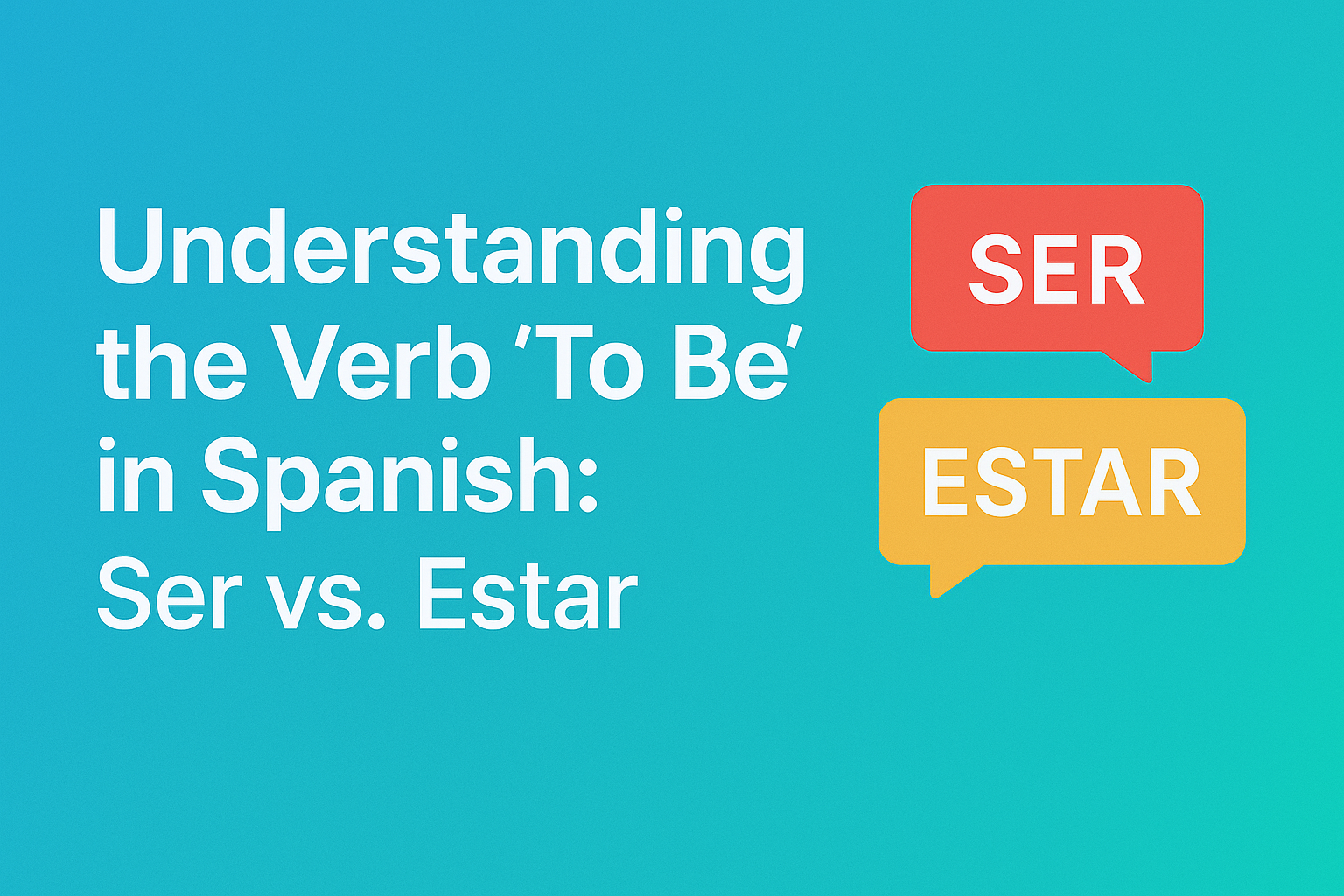Understanding the Verb 'To Be' in Spanish: Ser vs. Estar


One of the most challenging concepts for English speakers learning Spanish is the distinction between the two verbs that translate to "to be": ser and estar. In English, we use a single verb for all situations, but Spanish requires you to choose between these two verbs depending on the context. Mastering this distinction is fundamental to speaking Spanish correctly and naturally.
The Basic Distinction
While both verbs translate to "to be" in English, they serve different purposes:
- Ser (sair) generally refers to permanent or inherent characteristics, identity, origin, and possession.
- Estar (eh-STAR) generally refers to temporary conditions, locations, and ongoing actions.
However, this simplified explanation doesn't cover all uses. Let's explore both verbs in depth.
Conjugation: Present Tense
Before diving into usage, let's review how these verbs are conjugated in the present tense:
Ser
| Subject Pronoun | Conjugation |
|---|---|
| yo | soy |
| tú | eres |
| él/ella/usted | es |
| nosotros/nosotras | somos |
| vosotros/vosotras | sois |
| ellos/ellas/ustedes | son |
Estar
| Subject Pronoun | Conjugation |
|---|---|
| yo | estoy |
| tú | estás |
| él/ella/usted | está |
| nosotros/nosotras | estamos |
| vosotros/vosotras | estáis |
| ellos/ellas/ustedes | están |
Notice that both verbs are irregular, meaning they don't follow the standard conjugation patterns of Spanish verbs.
When to Use Ser
1. Identity and Definition
Use ser to identify who or what something is:
- Yo soy estudiante. (I am a student.)
- Esto es un libro. (This is a book.)
- Ellos son mis padres. (They are my parents.)
2. Origin/Nationality
Use ser to indicate where someone or something is from:
- Soy de México. (I am from Mexico.)
- ¿De dónde eres? (Where are you from?)
- Este vino es de Francia. (This wine is from France.)
3. Inherent Characteristics
Use ser for qualities considered permanent or inherent:
- La nieve es fría. (Snow is cold.)
- Soy alto. (I am tall.)
- Mi hermana es inteligente. (My sister is intelligent.)
4. Time and Dates
Use ser to tell time or refer to dates:
- Son las tres de la tarde. (It's three in the afternoon.)
- Hoy es martes. (Today is Tuesday.)
- Es el 15 de septiembre. (It's September 15th.)
5. Occupation
Use ser to indicate profession or occupation:
- Mi padre es médico. (My father is a doctor.)
- ¿Eres profesor? (Are you a teacher?)
- Somos estudiantes. (We are students.)
6. Possession
Use ser to express ownership:
- Este coche es de Juan. (This car is Juan's.)
- ¿De quién es este lápiz? (Whose pencil is this?)
- Esos libros son míos. (Those books are mine.)
7. Materials
Use ser to describe what something is made of:
- La mesa es de madera. (The table is made of wood.)
- Los anillos son de oro. (The rings are made of gold.)
8. Events/Locations of Events
Use ser for events and their locations:
- La boda es en la iglesia. (The wedding is at the church.)
- La fiesta fue en mi casa. (The party was at my house.)
When to Use Estar
1. Location
Use estar to indicate the physical location of people or objects:
- Estoy en la biblioteca. (I am in the library.)
- Madrid está en España. (Madrid is in Spain.)
- ¿Dónde están mis llaves? (Where are my keys?)
2. Temporary Conditions
Use estar for conditions, emotions, or states that can change:
- Estoy cansado. (I am tired.)
- ¿Estás enfermo? (Are you sick?)
- El cielo está nublado. (The sky is cloudy.)
3. Current Actions (with Present Progressive)
Use estar with the gerund (-ando, -iendo) to form the present progressive tense:
- Estoy estudiando español. (I am studying Spanish.)
- Ellos están comiendo. (They are eating.)
- ¿Qué estás haciendo? (What are you doing?)
4. Results of Actions
Use estar to describe results or conditions caused by a previous action:
- La puerta está cerrada. (The door is closed.)
- Los vasos están limpios. (The glasses are clean.)
- La comida está lista. (The food is ready.)
5. Death
Interestingly, estar is used to indicate death, perhaps because it's viewed as a state:
- Mi abuelo está muerto. (My grandfather is dead.)
Changing Meanings with Ser vs. Estar
One of the most fascinating aspects of the ser/estar distinction is that some adjectives change their meaning depending on which verb is used:
Examples of Changing Meanings
| Adjective | With Ser | With Estar |
|---|---|---|
| aburrido | to be boring | to be bored |
| listo | to be clever | to be ready |
| rico | to be wealthy | to be tasty (food) |
| verde | to be green (color) | to be unripe |
| vivo | to be lively/clever | to be alive |
Specific Examples in Sentences
-
La película es aburrida. (The movie is boring - inherent quality)
-
Estoy aburrido. (I am bored - current state)
-
Juan es listo. (Juan is clever - inherent trait)
-
Juan está listo. (Juan is ready - current state)
-
Ella es rica. (She is wealthy - permanent condition)
-
La sopa está rica. (The soup is delicious - temporary assessment)
Common Mistakes and How to Avoid Them
Mistake 1: Using Ser for Emotions
Incorrect: Soy triste. (I am sad.) Correct: Estoy triste. (I am sad.)
Remember: Emotions are temporary states, so use estar.
Mistake 2: Using Estar for Identity
Incorrect: Estoy un estudiante. (I am a student.) Correct: Soy un estudiante. (I am a student.)
Remember: Identity and roles use ser.
Mistake 3: Confusion with Appearance
Incorrect: Ella está guapa. (When referring to inherent beauty) Correct: Ella es guapa. (She is beautiful - permanent trait) Also Correct: Ella está guapa hoy. (She looks beautiful today - temporary state)
Mistake 4: Location of Events
Incorrect: La fiesta está en mi casa. Correct: La fiesta es en mi casa. (The party is at my house.)
Remember: Events use ser, even when expressing location.
Memory Aids for Ser vs. Estar
The PLACE Rule for Estar
Remember PLACE for situations requiring estar:
- Position (location)
- Location
- Action (ongoing)
- Condition (temporary)
- Emotion
The DOCTOR Rule for Ser
Remember DOCTOR for situations requiring ser:
- Description (inherent traits)
- Occupation
- Characteristic (inherent)
- Time
- Origin/ownership
- Relationship/identity
Rhyme to Remember
"For how you feel and where you are, always use the verb estar. For who you are and where you're from, use ser, you'll get the job done."
Practice Exercises
Exercise 1: Fill in the Blank
Choose between ser and estar:
- Yo _____ de California.
- Mi madre _____ en el supermercado ahora.
- _____ las ocho de la mañana.
- La sopa _____ caliente.
- Nosotros _____ estudiantes.
Answers: 1. soy, 2. está, 3. Son, 4. está, 5. somos
Exercise 2: Translate to Spanish
- I am happy today.
- She is a doctor.
- The party is at my house.
- We are studying now.
- The book is on the table.
Answers:
- Estoy feliz hoy.
- Ella es doctora.
- La fiesta es en mi casa.
- Estamos estudiando ahora.
- El libro está en la mesa.
Advanced Concepts: Regional Variations
Like many aspects of Spanish, there are regional variations in how ser and estar are used:
In Latin America
Some Latin American regions may use estar in situations where Spaniards might use ser:
- ¿Cómo estás de alto? (How tall are you?) - Latin American variation
- ¿Cuán alto eres? (How tall are you?) - Spain
Progressive Tense Variations
Some Spanish-speaking regions use estar + gerund more frequently than others to express actions in progress.
Conclusion
Mastering the distinction between ser and estar is a fundamental step in becoming proficient in Spanish. While it may seem challenging at first, with practice, the correct choice will become second nature. Remember that language is flexible, and there are sometimes gray areas where both verbs might be acceptable depending on what you want to emphasize.
Practice these concepts regularly in real conversations, and don't be afraid to make mistakes. Spanish speakers are generally understanding of this common challenge for learners. With time, you'll develop an intuitive sense of which verb to use in any situation.
¡Buena suerte con tu estudio del español! (Good luck with your Spanish study!)